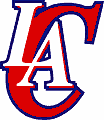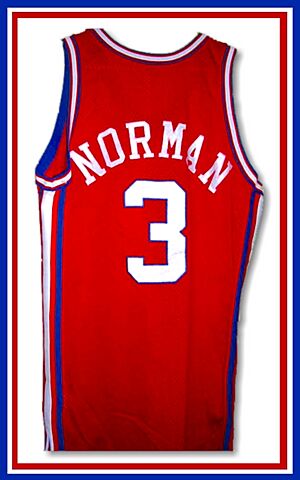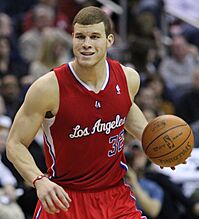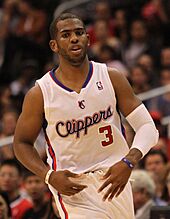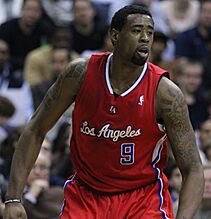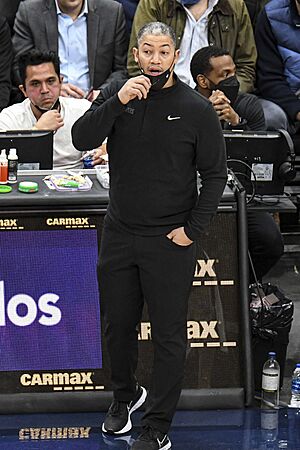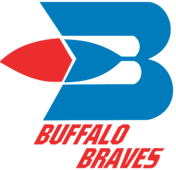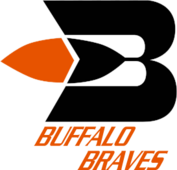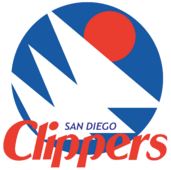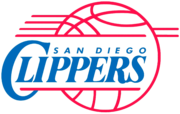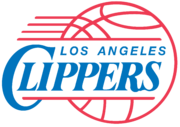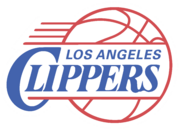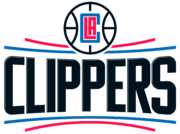Los Angeles Clippers facts for kids
Quick facts for kids Los Angeles Clippers |
|||||
|---|---|---|---|---|---|
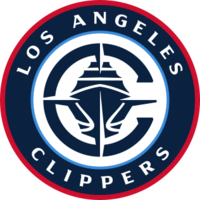 |
|||||
| Conference | Western | ||||
| Division | Pacific | ||||
| Founded | 1970 | ||||
| History | Buffalo Braves 1970–1978 San Diego Clippers 1978–1984 Los Angeles Clippers 1984–present |
||||
| Arena | Intuit Dome | ||||
| Location | Inglewood, California | ||||
| Team colors | Navy blue, ember red, Pacific blue, silver |
||||
| Main sponsor | None | ||||
| President | Lawrence Frank | ||||
| General manager | Trent Redden | ||||
| Head coach | Tyronn Lue | ||||
| Ownership | Steve Ballmer | ||||
| Affiliation(s) | San Diego Clippers | ||||
| Championships | 0 | ||||
| Conference titles | 0 | ||||
| Division titles | 3 (2013, 2014, 2024) | ||||
|
|||||
The Los Angeles Clippers are a professional basketball team from the Greater Los Angeles area. They play in the National Basketball Association (NBA). The Clippers are part of the Pacific Division in the Western Conference. Since the 2024–25 NBA season, their home games are at Intuit Dome in Inglewood, California. Before that, they shared Crypto.com Arena in Los Angeles with the Los Angeles Lakers from 1999 to 2024. Fans often call them "the Clips" or "LAC".
The team started in 1970 as the Buffalo Braves. They were a new team joining the league. With star player Bob McAdoo, the Braves made it to the NBA playoffs three times. In 1978, the team moved from Buffalo to San Diego, California. They changed their name to the San Diego Clippers, named after the fast sailing ships in San Diego Bay. The team did not do well in San Diego and never reached the playoffs.
In 1984, the owner, Donald Sterling, moved the team to Los Angeles. This move happened without the NBA's full approval at first. For their first 27 years in Los Angeles, the Clippers only made the playoffs four times. They won just one playoff series. Because of this, they were often seen as a team that always lost. People often compared them to the very successful Lakers.
Things changed for the Clippers in the 2010s. They became a strong team that often made the playoffs. With players like Blake Griffin, DeAndre Jordan, and Chris Paul, they were known as "Lob City." They made the playoffs six years in a row from 2012 to 2017. They also won their division twice in 2013 and 2014. These were big firsts for the team. Even with this success, they often struggled in the playoffs. They reached the conference finals for the first time in 2021. The Clippers are the oldest team in North American professional sports that has never played in a championship game.
Contents
- Team History
- 1970–1978: Buffalo Braves Era
- 1978–1984: San Diego Clippers Era
- 1984–1989: Moving to Los Angeles and Early Challenges
- 1989–1994: Playoff Appearances
- 1994–2000: New Arenas and Continued Challenges
- 2000–2009: More Struggles at Staples Center
- 2009–2011: The Arrival of Blake Griffin
- 2011–2017: Chris Paul and "Lob City"
- 2017–2019: Rebuilding the Team
- 2019–Present: The Kawhi Leonard Era
- Team Rivalries
- Season Records
- Home Arenas Over Time
- Team Logos and Uniforms
- Team Personnel
- Head Coaches
- ClipperVision Streaming Service
- See also
Team History
1970–1978: Buffalo Braves Era
The team started in Western New York as the Buffalo Braves. They were one of three new NBA teams in the 1970–71 season. Their home games were at the Buffalo Memorial Auditorium. They shared the arena with the National Hockey League's Buffalo Sabres.
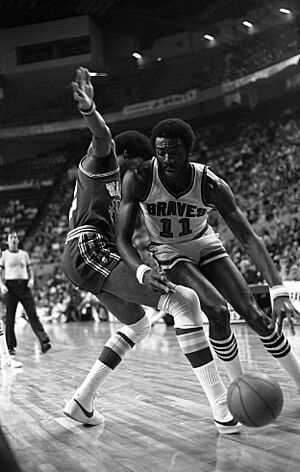
After two tough seasons, the Braves got better with coach Jack Ramsay and star center Bob McAdoo. McAdoo was the NBA's top scorer for three years in a row. He was named the league's MVP in the 1974–75 season. The Braves made the playoffs three times in a row. However, they often lost to strong teams like the Boston Celtics. The team had problems scheduling games at their arena. Another local basketball team, the Canisius Golden Griffins, had priority.
The team's owner, Paul Snyder, sold the team. The new owner, John Y. Brown, Jr., traded away many of the team's best players. This made attendance drop. In 1978, Brown traded ownership of the Braves with Celtics owner Irv Levin. Levin then moved the Braves to San Diego.
1978–1984: San Diego Clippers Era
In 1978, the Braves team moved to San Diego. The city had an NBA team before, the San Diego Rockets, but they moved in 1971. San Diego officials decided to rename the team the "Clippers." This name honored the famous sailing ships in San Diego Bay. Gene Shue became the first head coach of the Clippers.
The 1978–79 season started slowly. The team lost many early games. Player World B. Free became a top scorer and a fan favorite. He finished second in NBA scoring that season. The Clippers improved and won half of their games. They finished with a 43–39 record, just missing the playoffs. This was also the first season for long-time announcer Ralph Lawler.
The 1979–80 season was tougher. They added center Bill Walton, a San Diego native who had won an NBA Championship. But Walton missed many games due to foot injuries. The team finished 35–47. Walton missed the entire next season too.
In 1981, Los Angeles real estate developer Donald Sterling bought the team. The Clippers continued to play poorly. Sterling was fined by the NBA for some of his actions, like making players fly in coach seats. He tried to move the team to Los Angeles in 1982, but the NBA said no. The league even considered removing Sterling as owner. However, he eventually made a deal to keep the team. The Clippers' last two seasons in San Diego were not much better.
In 1984, Sterling moved the Clippers to Los Angeles again, even though the NBA said no. The NBA fined Sterling $25 million. Sterling then sued the league. Eventually, in 1987, the league and Sterling agreed to drop their lawsuits. This allowed the team to stay in Los Angeles, and Sterling's fine was reduced.
Forty years after the Clippers left San Diego, their G League team moved to San Diego in 2024. They also adopted the San Diego Clippers name.
1984–1989: Moving to Los Angeles and Early Challenges
In 1984, the Clippers began playing at the Los Angeles Memorial Sports Arena. Their first season in Los Angeles ended with a 31–51 record.
The Clippers had many tough seasons in their early years in Los Angeles. Many of their talented players suffered serious injuries. This problem was sometimes called the "Clipper Triangle." For example, Derek Smith had a knee injury in 1985–86. Norm Nixon and Marques Johnson also had major injuries. The team's 12–70 record in 1987 was one of the worst in NBA history at the time. That same season, Hall of Famer Elgin Baylor joined the team as general manager.
1989–1994: Playoff Appearances
The Clippers started to get better in the late 1980s and early 1990s. They traded for high-scoring player Ron Harper in 1989. With players like Ken Norman, Danny Manning, and Loy Vaught, the team became a playoff contender.
In the middle of the 1991–92 season, Larry Brown became the new head coach. He led the team to a 45–37 record, their first winning season in 13 years. They even finished with a better record than the Los Angeles Lakers. The Clippers made the playoffs for the first time in 16 years. They lost in the first round to the Utah Jazz. The team made the playoffs again in the 1992–93 season but lost in the first round to the Houston Rockets.
Larry Brown left after that season. The 1993–94 season was one of the worst for the Clippers. They traded Danny Manning for Dominique Wilkins. Wilkins played well but left after one year.
1994–2000: New Arenas and Continued Challenges
From 1994 to 1999, the Clippers played some games each year at the Arrowhead Pond of Anaheim (now Honda Center). This arena is in Anaheim, a city south of Los Angeles. The Clippers often had more fans at games in Anaheim than in Los Angeles. There were talks about the team moving to Anaheim permanently. However, owner Donald Sterling turned down a deal to move the team.
On the court, the Clippers kept changing players. They made the playoffs only once under coach Bill Fitch. The 1996–97 team made the playoffs with a losing record (36–46). They were swept in the first round by the Utah Jazz.
After the 1997–98 season, Fitch was fired. The Clippers got the first pick in the 1998 Draft and chose center Michael Olowokandi. The team had a very bad record in the lockout-shortened 1998–99 season. They then drafted Lamar Odom.
In 1999, the Clippers moved to the new Staples Center (now Crypto.com Arena) in Downtown Los Angeles. They shared the arena with the Lakers and the Los Angeles Kings. The Lakers and Kings had priority for scheduling games. The Clippers finished the 1999–2000 season with the worst record in the league.
2000–2009: More Struggles at Staples Center
The 2000–01 season brought some new players like Corey Maggette, Darius Miles, and Quentin Richardson. The team improved slightly, finishing 31–51.
To get better, the Clippers traded for power forward Elton Brand in 2001. Brand became an All-Star. The Clippers played well for most of the 2001–02 season, but missed the playoffs. They finished 39–43. The next season, they traded for Andre Miller. But injuries and poor team chemistry led to a disappointing 27–55 record.
After that tough season, many key players left. The team kept Brand and Maggette. With new coach Mike Dunleavy, Sr., they finished 28–54 in 2003–04. The next season, they missed the playoffs again. However, they had a better record than the Lakers for the first time since 1993.
The 2005–06 season was a big turning point. The team played very well, with Elton Brand leading the way. They had their first winning record in 14 seasons. They also made the playoffs for the first time since 1997. They finished sixth in the Western Conference with a 47–35 record.
On April 22, 2006, the Clippers won their first playoff game in 13 years. They won their first playoff series since moving from Buffalo. In the next round, they faced the Phoenix Suns. It was a close series that went to seven games. The Clippers played hard but lost the final game. General Manager Elgin Baylor won the NBA Executive of the Year award for the team's success.
The 2006–07 season was disappointing. Key players like Sam Cassell and Chris Kaman had injuries. Star player Shaun Livingston suffered a very serious knee injury. The Clippers finished 40–42 and missed the playoffs.
The 2007–08 season started badly when Elton Brand got a serious Achilles tendon injury. The team struggled and finished 23–59. Both Brand and Maggette left the team. The Clippers signed Baron Davis and drafted Eric Gordon and DeAndre Jordan.
In October 2008, Elgin Baylor left his role as general manager after 22 years. Coach Mike Dunleavy, Sr. took over as general manager. The 2008–09 season ended with a 19–63 record. The team then got the first pick in the 2009 NBA draft.
2009–2011: The Arrival of Blake Griffin
With the first pick, the Clippers chose Blake Griffin. Griffin looked great in preseason. However, he broke his kneecap in the final exhibition game. This injury kept him out for the entire season.
In February 2010, coach Mike Dunleavy resigned. Kim Hughes became the interim coach. The Clippers improved slightly, finishing 29–53. Hughes was fired at the end of the season.
In July, Vinny Del Negro was hired as the new head coach. The team also got new uniform designs. Griffin finally made his debut in the 2010–11 season. He quickly became a star, known for his amazing dunks. Griffin was chosen as an All-Star, which is rare for a rookie. He also won the NBA Slam Dunk Contest and was named Rookie of the Year. The team finished 32–50.
2011–2017: Chris Paul and "Lob City"
In December 2011, the Clippers made a huge trade. They acquired four-time All-Star Chris Paul from the New Orleans Hornets. Paul and Griffin became starters for the Western Conference All-Star team. This was the first time the Clippers had two All-Star starters in the same year.
The team earned the nickname "Lob City." This was because Griffin said, "Yeah! It's going to be lob city!" after hearing about Chris Paul joining the team. This referred to the many alley-oop dunks they would perform.
In February 2012, veteran player Chauncey Billups suffered a torn Achilles tendon and missed the rest of the season. Despite this, the Clippers played very well. They won 12 of their last 14 games. They clinched their first playoff spot since the 2005–06 season.
In their first playoff game, the Clippers made an amazing comeback. They were down by 27 points but won 99–98 against the Grizzlies. They won the series in seven games. In the second round, they were swept by the San Antonio Spurs.
In the 2012 off-season, the team brought back Lamar Odom. They also signed Jamal Crawford and re-signed Billups. The Clippers had a record-breaking winning streak in December 2012. They won 17 games in a row, which was the longest streak in team history. They also had an undefeated month, going 16–0 in December.
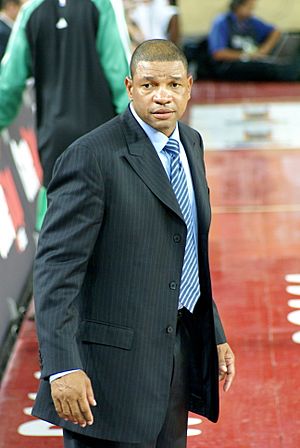
On April 7, 2013, the Clippers beat the Lakers and won their first division title ever. They finished the season with a 56–26 record. In the playoffs, they again faced the Memphis Grizzlies. They lost the series in the first round. After this, the team hired Doc Rivers as their new head coach.
In July 2013, the Clippers traded for JJ Redick. They also re-signed Chris Paul to a big contract. On March 6, 2014, the Clippers had their biggest win ever, beating the Lakers by 48 points. On April 15, they broke the franchise record for wins with 57. In the playoffs, they beat the Golden State Warriors in seven games. But they lost to the Oklahoma City Thunder in the second round.
Donald Sterling Controversy
In April 2014, team owner Donald Sterling was involved in a controversy. He made inappropriate comments. The NBA investigated and banned Sterling for life from the league. He was also fined $2.5 million. The NBA forced Sterling to sell the team. Steve Ballmer, a former CEO of Microsoft, bought the team for $2 billion. This was a very high price. Ballmer promised to keep the team in Los Angeles.
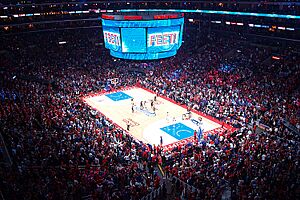
The Clippers' first season under Steve Ballmer ended with a 56–26 record. They made the playoffs in 2015. They beat the defending champion San Antonio Spurs in a thrilling seven-game series. In the next round, they had a 3–1 lead against the Houston Rockets. But Houston won the last three games, eliminating the Clippers.
In the 2016 playoffs, the Clippers lost in the first round to the Portland Trail Blazers. The 2016–17 season was their fifth straight with 50 wins. They lost in seven games to the Utah Jazz in the first round of the playoffs.
2017–2019: Rebuilding the Team
The Clippers started to rebuild their team. They brought in Jerry West as a special consultant. In June 2017, Chris Paul was traded to the Houston Rockets. The team also traded for Danilo Gallinari. Later, Blake Griffin was traded to the Detroit Pistons. Even with these changes, the team finished with a winning record in 2018 but missed the playoffs.
In the 2018 NBA draft, the Clippers drafted Shai Gilgeous-Alexander. Long-time Clipper DeAndre Jordan left the team. Despite losing Griffin and Jordan, the Clippers made the playoffs in the 2018–19 season. They finished with a 48–34 record. They faced the Golden State Warriors in the first round and lost in six games.
2019–Present: The Kawhi Leonard Era
2019–2024: The Paul George and Kawhi Leonard Duo
In 2019, Kawhi Leonard joined the Clippers. The team also traded for Paul George from the Oklahoma City Thunder. This created a powerful duo.
After the NBA season was paused in 2020, the Clippers played in the "NBA Bubble." They finished with a 49–23 record, as the second-best team in the Western Conference. Despite high hopes, they lost to the Denver Nuggets in seven games in the conference semifinals. A week later, Doc Rivers stepped down as head coach. Tyronn Lue became the new coach.
In the 2021 playoffs, even though Kawhi Leonard was injured, the Clippers beat the top-seeded Utah Jazz. This led them to their first Western Conference finals appearance ever. They lost the conference finals in six games to the Phoenix Suns.
On September 17, 2021, construction began for Intuit Dome, the Clippers' new home arena. Kawhi Leonard missed the entire 2021–22 season due to injury. The Clippers finished 42–40 and made the play-in game but did not reach the playoffs.
In the next season, the Clippers acquired former MVP Russell Westbrook. They finished 44–38 and made the playoffs. However, injuries to Kawhi Leonard and Paul George led to an early exit in the first round.
Near the start of the 2023–24 season, the Clippers traded for former MVP James Harden. In their final season at the Crypto.com Arena, the Clippers started slowly. But they improved greatly when Terance Mann joined the starting lineup. They clinched a playoff spot on April 11, 2024. They finished as the fourth seed with a 51–31 record. The Clippers were defeated in six games by the Dallas Mavericks.
Move to Intuit Dome
In 2017, the Clippers and the city of Inglewood agreed to build a new arena. This privately funded arena, Intuit Dome, was completed in 2024. It is located near SoFi Stadium. The arena also has a practice facility and team headquarters.
The plan for the new arena faced opposition from the nearby Forum. The Forum's owner, the Madison Square Garden Company, worried about competition. In March 2020, Clippers owner Steve Ballmer bought The Forum. This removed the opposition to the new arena.
On September 17, 2021, the Clippers revealed details about the new arena. It cost up to $2 billion. The arena was named Intuit Dome through a large naming rights deal with Intuit.
2024–Present: Changes to the Roster
In the 2024–25 off-season, the Clippers moved to their new home arena and updated their branding. They saw Paul George and Russell Westbrook leave the team. The Clippers re-signed James Harden.
Kawhi Leonard returned to play in January 2025 after missing the first 34 games due to injury. James Harden represented the Clippers at the All-Star Game.
Team Rivalries
Los Angeles Lakers
The rivalry between the Clippers and the Los Angeles Lakers is special. They were the only two NBA teams to share an arena, Crypto.com Arena, until the Clippers moved to Intuit Dome in 2024. It is one of only two rivalries in the NBA between teams in the same city.
Historically, Lakers fans have been much more numerous. Some people say it is not a true rivalry because the Lakers have won so much more than the Clippers.
Season Records
Here are the results for the Clippers' last five seasons:
| Season | GP | W | L | W–L% | Finish | Playoffs |
| 2020–21 | 72 | 47 | 25 | .653 | 2nd, Pacific | Lost in conference finals, 2–4 (Suns) |
| 2021–22 | 82 | 42 | 40 | .512 | 3rd, Pacific | Did not qualify |
| 2022–23 | 82 | 44 | 38 | .537 | 3rd, Pacific | Lost in first round, 1–4 (Suns) |
| 2023–24 | 82 | 51 | 31 | .622 | 1st, Pacific | Lost in first round, 2–4 (Mavericks) |
| 2024–25 | 82 | 50 | 32 | .610 | 2nd, Pacific | Lost in first round, 3–4 (Nuggets) |
Home Arenas Over Time
- Buffalo Memorial Auditorium (1970–1978)
- San Diego Sports Arena (1978–1984)
- Los Angeles Memorial Sports Arena (1984–1999)
- Crypto.com Arena (1999–2024)
- Intuit Dome (2024–present)
Team Logos and Uniforms
- Previous logos of the Los Angeles Clippers
When the team moved to San Diego and became the Clippers, their uniforms were light blue with orange. Their first logo showed a blue circle with three white sails, representing a clipper ship.
In 1982, the Clippers changed their logo and uniforms. They used royal blue and red colors. The uniforms had the team name on the front. When they moved to Los Angeles in 1984, they kept this look. The logo was a white basketball with red lines.
In 1987, the uniforms changed again. Red became the main color, with blue as a trim. The home white uniforms had the team name in script. The road red uniforms sometimes had the city name.
In 1999, the Clippers made small changes to their uniforms. They added an "LAC" logo on the neckline. In 2010, they changed their uniforms again, adjusting the stripes and letters.
On June 18, 2015, the Clippers showed off a new look. Their main logo featured a basketball shaped like a compass. It had the "LAC" letters in the middle. Below it was the team name in black. Two curved lines below the name represented the ocean horizon, honoring their sailing roots.
The Clippers also introduced a black alternate uniform in 2015. This uniform celebrated downtown Los Angeles.
In 2017, the Clippers unveiled new Nike uniforms. They replaced their red road uniform with a new blue "Icon" uniform. They also kept their black "Statement" uniform.
The team also started using "City" uniforms. For the 2017–18 season, they brought back the classic San Diego light blue and orange. These uniforms had nautical flags spelling "LAC." In 2018–19, they wore navy blue City uniforms to honor their 35th season in Los Angeles. In 2019–20, they wore white City uniforms with "Los Angeles" in a special font. This honored Los Angeles street culture.
The 2021–22 "City" uniform mixed different styles from the past. It included the light blue and orange from the Buffalo/San Diego era. It also had the "Clippers" script from 1987 to 2015.
In the 2022–23 season, the Clippers wore black "City" uniforms. These honored the Drew League, a summer basketball tournament in Los Angeles. The 2023–24 "City" uniform featured the nickname "Clips."
Starting with the 2024–25 season, the Clippers unveiled new modern uniforms. The logo now features a stylized clipper ship around a navy blue "C." The "Association" white uniform has the modernized "Clippers" wordmark in navy blue. The "Icon" navy blue uniform has the "Clippers" script in red. The red "Statement" uniform has "Los Angeles" stacked.
Team Personnel
Basketball Hall of Famers
| Los Angeles Clippers Hall of Famers | ||||
|---|---|---|---|---|
| Players | ||||
| No. | Name | Position | Tenure | Inducted |
| 32 | Bill Walton | C | 1979–1985 | 1993 |
| 11 | Bob McAdoo | F/C | 1972–1976 | 2000 |
| 20 | Moses Malone | C/F | 1976 | 2001 |
| 21 | Dominique Wilkins | F | 1994 | 2006 |
| 44 | Adrian Dantley | F/G | 1976–1977 | 2008 |
| 52 | Jamaal Wilkes | F | 1985 | 2012 |
| 33 | Grant Hill | F | 2012–2013 | 2018 |
| 34 | Paul Pierce | F | 2015–2017 | 2021 |
| 1 | Chauncey Billups | G | 2011–2013 | 2024 |
| Coaches | ||||
| Jack Ramsay | Head coach | 1972–1976 | 1992 | |
| Larry Brown | Head coach | 1992–1993 | 2002 | |
| Bill Fitch | Head coach | 1994–1998 | 2019 | |
| Contributors | ||||
| Cotton Fitzsimmons | Head coach | 1977–1978 | 2021 | |
| Jerry West | Executive | 2017–2024 | 2024 | |
Franchise Leaders
Bold means the player is still with the team. Italic means the player is still active but not with the team.
Regular season (as of the end of the 2024–25 season)
Points
- Randy Smith (12,735)
- Blake Griffin (10,863)
- Bob McAdoo (9,434)
- Elton Brand (9,174)
- Corey Maggette (8,835)
- Chris Paul (7,674)
- Danny Manning (7,120)
- DeAndre Jordan (7,078)
- Loy Vaught (6,614)
- Kawhi Leonard (6,483)
- Ken Norman (6,432)
- Paul George (6,049)
- Ron Harper (5,853)
- Chris Kaman (5,813)
- Jamal Crawford (5,675)
- Benoit Benjamin (5,405)
- Eric Piatkowski (5,269)
- Ivica Zubac (5,227)
- Charles Smith (4,994)
- Lou Williams (4,975)
- Bob Kauffman (4,847)
- Swen Nater (4,694)
- Freeman Williams (4,467)
- World B. Free (4,299)
- JJ Redick (4,208)
- Lamond Murray (4,173)
- Norm Nixon (4,127)
- Michael Brooks (4,010)
- Lamar Odom (3,986)
- Gary Grant (3,899)
| Most minutes played | |
|---|---|
| Player | Minutes |
| Randy Smith | 24,393 |
| DeAndre Jordan | 21,045 |
| Blake Griffin | 17,706 |
| Elton Brand | 17,595 |
| Corey Maggette | 15,780 |
| Loy Vaught | 15,671 |
| Chris Kaman | 14,661 |
| Chris Paul | 13,885 |
| Ken Norman | 13,584 |
| Bob McAdoo | 13,381 |
| Most rebounds | |
|---|---|
| Player | Rebounds |
| DeAndre Jordan | 7,988 |
| Elton Brand | 4,710 |
| Blake Griffin | 4,686 |
| Loy Vaught | 4,471 |
| Ivica Zubac | 4,298 |
| Bob McAdoo | 4,229 |
| Swen Nater | 4,168 |
| Chris Kaman | 4,109 |
| Benoit Benjamin | 3,538 |
| Randy Smith | 2,985 |
| Most assists | |
|---|---|
| Player | Assists |
| Chris Paul | 4,023 |
| Randy Smith | 3,498 |
| Gary Grant | 2,810 |
| Norm Nixon | 2,540 |
| Blake Griffin | 2,133 |
| Ron Harper | 1,463 |
| Ernie DiGregorio | 1,457 |
| Mark Jackson | 1,402 |
| Baron Davis | 1,398 |
| Pooh Richardson | 1,397 |
| Most steals | |
|---|---|
| Player | Steals |
| Randy Smith | 1,072 |
| Chris Paul | 902 |
| Gary Grant | 747 |
| Ron Harper | 606 |
| Danny Manning | 548 |
| Blake Griffin | 484 |
| Loy Vaught | 468 |
| DeAndre Jordan | 448 |
| Elton Brand | 438 |
| Kawhi Leonard | 426 |
| Most blocks | |
|---|---|
| Player | Blocks |
| DeAndre Jordan | 1,277 |
| Benoit Benjamin | 1,117 |
| Elton Brand | 1,039 |
| Chris Kaman | 707 |
| Bob McAdoo | 614 |
| Michael Olowokandi | 527 |
| Ivica Zubac | 500 |
| Gar Heard | 477 |
| Charles Smith | 451 |
| Bo Outlaw | 421 |
| Most three-pointers made | |
|---|---|
| Player | 3-pointers |
| Paul George | 820 |
| Eric Piatkowski | 738 |
| JJ Redick | 674 |
| Jamal Crawford | 662 |
| Chris Paul | 618 |
| Kawhi Leonard | 546 |
| Norman Powell | 473 |
| Lou Williams | 447 |
| James Harden | 421 |
Single-Season Records
| Category | Player | Statistics |
|---|---|---|
| Minutes played | Bob McAdoo | 3,539 |
| Field goals | Bob McAdoo | 1,095 |
| 3-point field goals | Paul George | 243 |
| Free throws | World B. Free | 654 |
| Offensive rebounds | DeAndre Jordan | 397 |
| Defensive rebounds | Swen Nater | 864 |
| Total rebounds | DeAndre Jordan | 1,226 |
| Assists | Norm Nixon | 914 |
| Steals | Randy Smith | 203 |
| Blocks | Bob McAdoo | 246 |
| Points | Bob McAdoo | 2,831 |
| Player efficiency rating | Chris Paul | 27.0 |
Individual Awards
NBA Rookie of the Year
- Terry Cummings – 1983
- Blake Griffin – 2011
NBA Most Improved Player
- Bobby Simmons – 2005
NBA Sixth Man of the Year
- Jamal Crawford – 2014, 2016
- Lou Williams – 2018, 2019
- Montrezl Harrell – 2020
NBA Sportsmanship Award
- Elton Brand – 2006
NBA Hustle Award
- Montrezl Harrell – 2020
NBA Teammate of the Year
- Chauncey Billups – 2013
NBA Executive of the Year
- Elgin Baylor – 2006
All-NBA First Team
- Chris Paul – 2012–2014
- DeAndre Jordan – 2016
- Kawhi Leonard – 2021
All-NBA Second Team
- Elton Brand – 2006
- Blake Griffin – 2012–2014
- Chris Paul – 2015, 2016
- Kawhi Leonard – 2020, 2024
All-NBA Third Team
- Dominique Wilkins – 1994
- Blake Griffin – 2015
- DeAndre Jordan – 2015, 2017
- Paul George – 2021
- James Harden – 2025
NBA All-Defensive First Team
- Chris Paul – 2012–2017
- DeAndre Jordan – 2015, 2016
NBA All-Defensive Second Team
- Patrick Beverley – 2020
- Kawhi Leonard – 2020, 2021
- Ivica Zubac – 2025
NBA All-Rookie First Team
- Terry Cummings – 1983
- Charles Smith – 1989
- Lamar Odom – 2000
- Darius Miles – 2001
- Al Thornton – 2008
- Blake Griffin – 2011
NBA All-Rookie Second Team
- Brent Barry – 1996
- Maurice Taylor – 1998
- Michael Olowokandi – 1999
- Eric Gordon – 2009
- Eric Bledsoe – 2011
- Shai Gilgeous-Alexander – 2019
- Landry Shamet – 2019
NBA All-Star Weekend
- World B. Free - 1980
- Norm Nixon – 1985
- Marques Johnson – 1986
- Danny Manning – 1993, 1994
- Elton Brand – 2002, 2006
- Chris Kaman – 2010
- Blake Griffin – 2011–2015
- Chris Paul – 2012–2016
- DeAndre Jordan – 2017
- Kawhi Leonard – 2020–2021, 2024
- Paul George - 2021, 2023–2024
- James Harden – 2025
NBA All-Star Game Most Valuable Player
- Randy Smith – 1978
- Chris Paul – 2013
- Kawhi Leonard – 2020
Slam Dunk champion
- Brent Barry – 1996
- Blake Griffin – 2011
Head Coaches
ClipperVision Streaming Service
In 2022, the Clippers started their own streaming service called ClipperVision. This service lets fans watch non-national Clippers games. It includes different viewing options, like one with analytics shown on screen. It also has broadcasts in Spanish and Korean.
See also
 In Spanish: Los Angeles Clippers para niños
In Spanish: Los Angeles Clippers para niños


